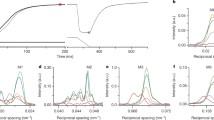Summary
We wished to find out why the internal resistance to shortening, which is negligible above rest length, becomes progressively more important with shortening below rest length. For this reason the movement of detached actin filaments in isometric sarcomeres treated with activating solution has been studied in insect flight muscle after breaking the filaments from the Z lines by stretching fibres in rigor. Evidence of sliding motion of such filaments has been produced by experimentally inducing double overlap zones in activating solution. It was deduced that the forces generated by individual crossbridges are comparable to the internal resistance to relative filament motion. Furthermore the final position of broken actin filaments indicated that wrongly polarized actin slides freely past activated crossbridges, but prevents these same bridges from exerting force on adjacent correctly polarized actin. Apparently only those bridges which are located in the normal overlap zones can generate effective force. It is therefore probable that the isometric tension is directly proportional to the number of bridges overlapped in the normal overlap zones for any sarcomere length equal to or greater than the thick filament length.
Similar content being viewed by others
References
BELÁGYI, J. & GARAMVÖLGYI, N. (1968) Mechanical properties of the flight muscle of the bee. II. Active isometric tension at different muscle lengths.Acta biochem. biophys. hung. 3 293–8.
BULLARD, B., BELL, J. L. & LUKE, B. M. (1977a) Immunological investigation of protein associated with thick filaments of insect flight muscle. InInsect Flight Muscle (edited by TREGEAR, R. T.), pp. 41–7. Amsterdam: Elsevier.
BULLARD, B., HAMMOND, K. S. & LUKE, B. M. (1977b) The site of paramyosin in insect flight muscle and the presence of an unidentified protein between myosin filaments and Z-lines.J. molec. Biol. 115 417–40.
GARAMVÖLGYI, N. (1965) The arrangement of the myofilaments in the insect flight muscle.J. Ultrastruct. Res. 13 409–24.
GARAMVÖLGYI, N. (1971) The functional morphology of muscle. InContractile Proteins and Muscle (edited by LAKI, K.), pp. 1–96. New York: Marcel Dekker.
GARAMVÖGLYI, N. & BELÁGYI, J. (1968) Mechanical properties of the flight muscle of bee. I. Resting elasticity and its ultrastructural interpretation.Acta biochim. biophys. hung. 3 195–204.
GORDON, H. M., HUXLEY, A. F. & JULIAN, F. J. (1966) The variation in isometric tension with sarcomere length in vertebrate muscle fibers.J. Physiol. 184 170–92.
HILL, A. V. (1953) The mechanics of active muscle.Proc. R. Soc. Ser. B 141 104–17.
HUXLEY, A. F. (1980) Uncertainties about ‘independent force generators’. InReflections on Muscle, pp. 52–67. Liverpool: University Press.
HUXLEY, A. F. & NIEDERGERKE, R. (1954) Interference microscopy of living muscle fibres.Nature 173 971–3.
HUXLEY, H. E. (1957) The double array of filaments in cross-striated muscle.J. biophys. biochem. Cytol. 3 631–48.
HUXLEY, H. E. (1960) Muscle cells. InThe Cell (edited by BRACHET, J. and MIRSKY, A. E.) New York: Academic Press.
HUXLEY, H. E. (1965) The mechanism of muscular contraction.213, 18–27.
MARSH, B. B. & CARSE, W. A. (1974) Meat tenderness and the sliding-filament hypothesis.J. Fd Technol. 9 129–39.
PRINGLE, J. W. S. (1967) The contractile mechanism of insect fibrillar muscle.Prog. Biophys. 17 1–60.
RAMSAY, R. W. & STREET, S. F. (1940) The isometric length-tension diagram of isolated skeletal muscle fibers of the frog.J. cell. comp. Physiol. 15 11–34.
REEDY, M. K. (1971) Electron microscope observations concerning the behaviour of the cross-bridges in striated muscle. InContractility of Muscle Cell and Related Processes (edited by PODOLSKY, R. J.), pp. 229–46. New York: Prentice Hall.
REEDY, M. K., HOLMES, K. C. & TREGEAR, R. T. (1965) Induced changes in orientation of the cross-bridges of glycerinated insect flight muscle.Nature 207 1276–80.
SAIDE, J. D. (1981) Identification of a connecting filament protein in insect fibrillar flight muscle.J. molec. Biol. 153 661–81.
TROMBITÁS, K. & TIGYI-SEBES, A. (1972) Continuity of thick and thin filaments.Acta biochem. biophys. hung. 7 193–4.
TROMBITÁS, K. & TIGYI-SEBES, A. (1974) Direct evidence for connecting (C) filaments in flight muscle of honey-bee.Acta biochim. biophys. hung. 9 243–53.
TROMBITÁS, K. & TIGYI-SEBES, A. (1977) Fine structure and mechanical properties of insect muscle. InInsect Flight Muscle (edited by TREGEAR, R. T.) pp. 79–90. Amsterdam: Elsevier.
TROMBITÁS, K. & TIGYI-SEBES, A. (1983) Contraction of glycerinated insect flight muscle as revealed in the electron microscopy.Acta biochim. biophys. hung. 16 37–8.
TROMBITÁS, K. & TIGYI-SEBES, A. (1984) Cross-bridge interaction with oppositely polarized actin filaments in the double-overlap zones of insect flight muscle.Nature 309 168–170.
TROMBITÁS, K., TIGYI-SEBES, A. & PALLAI, G. (1977) The paramyosin content and localisation in the honey bee. InInsect Flight Muscle (edited by TREGEAR, R. T.) pp. 53–6. Amsterdam: Elsevier.
WHITE, D. C. S. (1967)Structural and mechanical properties of insect fibrillar flight muscle in the relaxed and rigor state. D. Phil. thesis, University of Oxford.
WHITE, D. C. S. (1983) The elasticity of relaxed insect fibrillar flight muscle.J. Physiol. 343 31–57.
WHITE, D. C. S. & THORSON, J. (1973) The kinetics of muscle contraction.Prog. Biophys. 173–255.
Author information
Authors and Affiliations
Rights and permissions
About this article
Cite this article
Trombitás, K., Tigyi-Sebes, A. How actin filament polarity affects crossbridge force in doubly-overlapped insect muscle. J Muscle Res Cell Motil 6, 447–459 (1985). https://doi.org/10.1007/BF00712582
Received:
Revised:
Issue Date:
DOI: https://doi.org/10.1007/BF00712582




